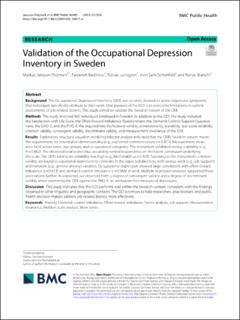| dc.description.abstract | Background
The Occupational Depression Inventory (ODI) was recently devised to assess depressive symptoms that individuals specifically attribute to their work. One purpose of the ODI is to overcome limitations in current assessments of job-related distress. This study aimed to validate the Swedish version of the ODI.
Methods
The study involved 365 individuals employed in Sweden. In addition to the ODI, the study included the Satisfaction with Life Scale, the Effort-Reward Imbalance Questionnaire, the Demand-Control-Support Questionnaire, the GAD-2, and the PHQ-9. We inquired into the factorial validity, dimensionality, scalability, test-score reliability, criterion validity, convergent validity, discriminant validity, and measurement invariance of the ODI.
Results
Exploratory structural equation modeling bifactor analysis indicated that the ODI’s Swedish version meets the requirements for essential unidimensionality (e.g., explained common variance = 0.872). Measurement invariance held across sexes, age groups, and occupational categories. The instrument exhibited strong scalability (e.g., H = 0.662). The observed total scores thus accurately ranked respondents on the latent continuum underlying the scale. The ODI’s total-score reliability was high (e.g., McDonald’s ω = 0.929). Speaking to the instrument’s criterion validity, we found occupational depression to correlate, in the expected direction, with various work (e.g., job support) and nonwork (e.g., general anxiety) variables. Occupational depression showed large correlations with effort-reward imbalance (r = 0.613) and demand-control imbalance (r = 0.566) at work. Multiple regression analyses supported these associations further. As expected, we observed both a degree of convergent validity and a degree of discriminant validity when examining the ODI against the PHQ-9, an attribution-free measure of depression.
Discussion
This study indicates that the ODI performs well within the Swedish context, consistent with the findings obtained in other linguistic and geographic contexts. The ODI promises to help researchers, practitioners, and public health decision-makers address job-related distress more effectively. | en_US |

